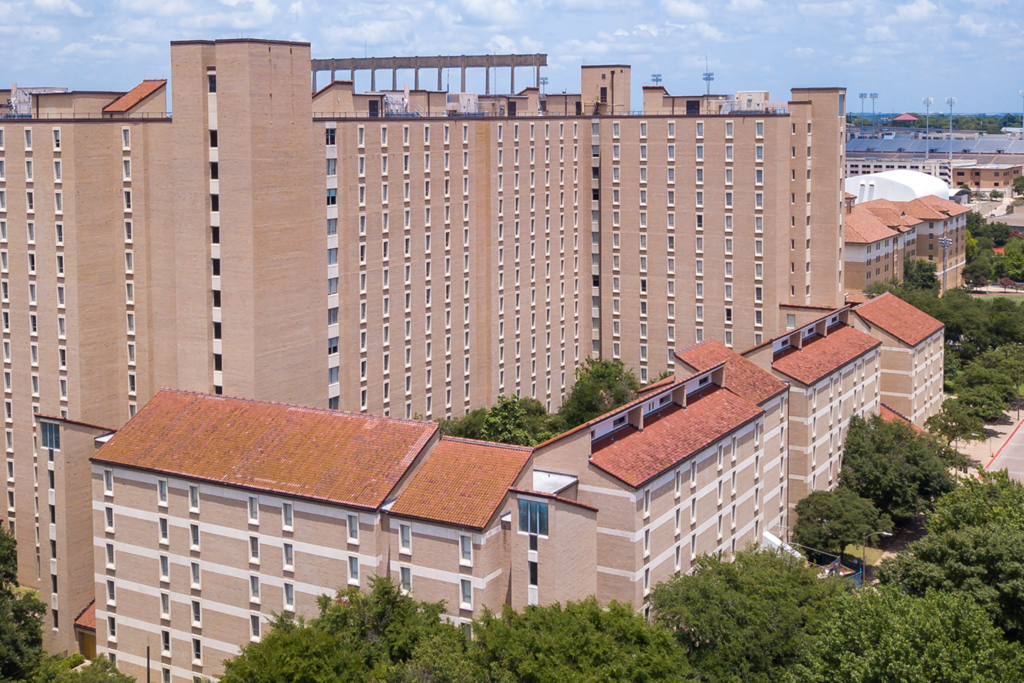by Adrienne Hunter
Imagine sharing a dorm room—changing your clothes, having personal phone conversations, receiving friends—with someone who finds your gender at best odd and at worst, some kind of medical or religious impossibility. That’s the situation of many trans students in campus housing at UT.

https://housing.utexas.edu/housing/residence-halls/residence-hall-locations
Trans students have been fighting for our safety on the University of Texas campus for more than fifteen years. This is documented in a detailed report on the state of LGBTQ affairs on campus, created in 2006 by the Queer Student Alliance after nearly a year of effort. The report includes over 60 recommendations for making the University more inclusive to queer folks. One of the report’s most emphatic recommendations called for an option for transgender students who live in campus housing to live in a single-person room with a private restroom that is easily accessible. Such a policy was not unheard-of, as schools like the University of Wisconsin and the University of Michigan did have Gender Inclusive Housing options. This report was one of the first widely known campaigns for gender-inclusive housing on campus, and it would be followed by many other powerful actions.
The authors of the report stated that they were encouraged that the University was “in the process of developing policies relating to transgender students in housing.” Yet students would continue to advocate for the university to improve its policies on the issue for years to come.
A notable example was a demonstration organized by StandOut in 2012. The students brought mattresses onto Speedway and acted as they normally would in their dorm rooms to show what it could look like for students of different genders to share a room. Soon after this demonstration, The University Residence Hall Organization unanimously approved a resolution advocating the implementation of Gender-Inclusive Housing on campus. In response, Director of Residence Life Hemlata Jhaveri said that Gender-Inclusive Housing could be implemented by 2013.
A pivotal development in the advocacy efforts for gender-inclusive housing came when the University of Texas at Dallas implemented a new system for Gender-Inclusive Housing. In response to this, a representative from the Division of Housing & Food Service at UT Austin informed The Daily Texan in an article from April 12, 2017 that there are informal ways they can work with students to create inclusive housing options on a case-by-case basis. However, this still did not meet calls from the original 2006 report for there to be a formal and accessible process, visible and equally available to all. He also said that there was a possibility of gender-inclusive housing launching at Creekside Residence Hall. There is still no such housing at Creekside.
It’s impossible to do your best work when you fear harassment or violence in your own bedroom, and repeatedly get the message that you don’t belong. In 2022, administrators are once again working with trans student advocates to create safe, equitable, and inclusive housing. We are looking forward to the day when we can put down our mattresses indoors instead of on Speedway.

Adrienne Hunter (she/her) is an undergraduate student pursuing majors in Radio-Television-Film, Women’s & Gender Studies, and Anthropology, as well as certificates in LGBTQ Studies and Creative Writing. She is currently the co-director of The Queer & Trans Student Alliance, where she aims to create a social space for LGBTQIA+ folks on campus while also focusing her energy on the inclusion of queer folks on campus. She is also a member of the Engaged Scholar Initiative where her research focuses on intergenerational dialogues of trans folks in Austin.
